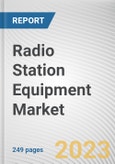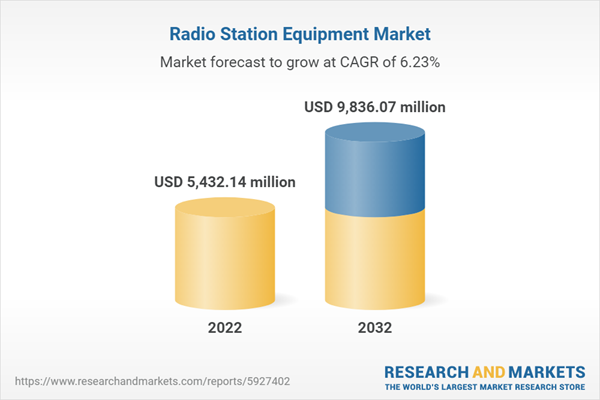Radio station equipment refers to various electronic devices and hardware used in the operation and broadcasting of a radio station. These components are essential for capturing, processing, and transmitting audio content to reach the station audience.
The adoption of HD Radio technology is a significant driver in the radio station equipment market. HD Radio offers the advantage of high-quality sound and additional data services, making it an attractive choice for both broadcasters and listeners. This increased adoption fuels demand for HD Radio transmitters, receivers, and related equipment, as radio stations seek to upgrade their capabilities to offer improved audio quality and additional content services. The shift towards HD Radio not only enhances the listening experience but also represents an opportunity for equipment manufacturers to provide advanced solutions, contributing toward the market growth and innovation in the radio station equipment sector.
However, changing consumer habits pose a significant restraint for the radio station equipment market. Traditional radio stations face challenges in retaining and attracting listeners with younger generations increasingly favoring digital and on-demand content platforms. This shift in consumption patterns can directly impact advertising revenue, as advertisers may redirect their budgets toward platforms with larger and more engaged digital audiences. Thus, radio stations may have limited resources to invest in equipment upgrades or innovations, hindering their ability to adapt to evolving technologies and stay competitive in a changing media landscape.
Despite facing challenges, studio automation and virtualization represent a significant opportunity in the radio station equipment market. These technologies allow radio stations to optimize their operations and reduce costs effectively. Companies specializing in advanced automation software, AI-driven production tools, and virtual studio setups can meet the growing demand for operational efficiency within the industry. These solutions enable radio stations to automate various aspects of their broadcasts, such as scheduling, content management, and even AI-driven content generation. Moreover, virtual studios reduce the need for physical infrastructure and space, further driving cost savings. By adopting these innovations, radio stations can optimize their operations, reduce manual labor, and enhance overall efficiency, making them highly attractive to broadcasters seeking to remain competitive while minimizing costs. This trend presents a promising growth opportunity for forward-thinking companies in the radio station equipment market.
The radio station equipment market is segmented on the basis of type, application, and region. By type, the radio station equipment market is fragmented into microphones, mixing consoles, transmitters, antennas, audio processors, headphones, and others. By application, the market is bifurcated into indoor and outdoor. By region, the market is analyzed across North America (U.S., Canada, and Mexico), Europe (UK, Germany, France, and rest of Europe), Asia-Pacific (China, Japan, India, South Korea, and rest of Asia-Pacific) and LAMEA (Latin America, Middle East, and Africa).
The major companies profiled in the report include Allen & Heath Limited, Behringer (Music Tribe Commercial MY Sdn. Bhd.), Guangdong Takstar Electronic Co., Ltd., HARMAN International, Icom America, Mackie (LOUD Audio, LLC), Roland Corporation, Sennheiser electronic GmbH & Co. KG, Shure Incorporated, and Yamaha Corporation.
Key Benefits For Stakeholders
- This report provides a quantitative analysis of the market segments, current trends, estimations, and dynamics of the radio station equipment market analysis from 2022 to 2032 to identify the prevailing radio station equipment market opportunities.
- The market research is offered along with information related to key drivers, restraints, and opportunities.
- Porter's five forces analysis highlights the potency of buyers and suppliers to enable stakeholders make profit-oriented business decisions and strengthen their supplier-buyer network.
- In-depth analysis of the radio station equipment market segmentation assists to determine the prevailing market opportunities.
- Major countries in each region are mapped according to their revenue contribution to the global market.
- Market player positioning facilitates benchmarking and provides a clear understanding of the present position of the market players.
- The report includes the analysis of the regional as well as global radio station equipment market trends, key players, market segments, application areas, and market growth strategies.
Additional benefits you will get with this purchase are:
- Quarterly Update and* (only available with a corporate license, on listed price)
- 5 additional Company Profile of client Choice pre- or Post-purchase, as a free update.
- Free Upcoming Version on the Purchase of Five and Enterprise User License.
- 16 analyst hours of support* (post-purchase, if you find additional data requirements upon review of the report, you may receive support amounting to 16 analyst hours to solve questions, and post-sale queries)
- 15% Free Customization* (in case the scope or segment of the report does not match your requirements, 15% is equivalent to 3 working days of free work, applicable once)
- Free data Pack on the Five and Enterprise User License. (Excel version of the report)
- Free Updated report if the report is 6-12 months old or older.
- 24-hour priority response*
- Free Industry updates and white papers.
Possible Customization with this report (with additional cost and timeline, please talk to the sales executive to know more)
- Product Benchmarking/Product specification and applications
- Product Life Cycles
- Supply Chain Analysis & Vendor Margins
- Market share analysis of players by products/segments
- New Product Development/Product Matrix of Key Players
- Additional company profiles with specific to client's interest
- Additional country or region analysis- market size and forecast
- Expanded list for Company Profiles
- Historic market data
- Key player details (including location, contact details, supplier/vendor network etc. in excel format)
- Market share analysis of players at global/region/country level
Key Market Segments
By Type
- Microphones
- Mixing consoles
- Transmitters
- Antennas
- Audio processors
- Others
By Application
- Indoor
- Outdoor
By Region
- North America
- U.S.
- Canada
- Mexico
- Europe
- UK
- Germany
- France
- Rest of Europe
- Asia-Pacific
- China
- Japan
- India
- South Korea
- Rest of Asia-Pacific
- LAMEA
- Latin America
- Middle East
- Africa
- Sennheiser Electronic GmbH & Co. KG
- Shure Incorporated
- Allen & Heath Limited
- Guangdong Takstar Electronic Co., Ltd.
- Mackie (LOUD Audio, LLC)
- Roland Corporation
- Yamaha Corporation
- Behringer (Music Tribe Commercial MY Sdn. Bhd.)
- HARMAN International
- Icom America Inc.
Please note:
- Online Access price format is valid for 60 days access. Printing is not enabled.
- PDF Single and Enterprise price formats enable printing.
Table of Contents
Companies Mentioned
- Sennheiser Electronic GmbH & Co. KG
- Shure Incorporated
- Allen & Heath Limited
- Guangdong Takstar Electronic Co., Ltd.
- Mackie (LOUD Audio, LLC)
- Roland Corporation
- Yamaha Corporation
- Behringer (Music Tribe Commercial MY Sdn. Bhd.)
- HARMAN International
- Icom America Inc.
Methodology
The analyst offers exhaustive research and analysis based on a wide variety of factual inputs, which largely include interviews with industry participants, reliable statistics, and regional intelligence. The in-house industry experts play an instrumental role in designing analytic tools and models, tailored to the requirements of a particular industry segment. The primary research efforts include reaching out participants through mail, tele-conversations, referrals, professional networks, and face-to-face interactions.
They are also in professional corporate relations with various companies that allow them greater flexibility for reaching out to industry participants and commentators for interviews and discussions.
They also refer to a broad array of industry sources for their secondary research, which typically include; however, not limited to:
- Company SEC filings, annual reports, company websites, broker & financial reports, and investor presentations for competitive scenario and shape of the industry
- Scientific and technical writings for product information and related preemptions
- Regional government and statistical databases for macro analysis
- Authentic news articles and other related releases for market evaluation
- Internal and external proprietary databases, key market indicators, and relevant press releases for market estimates and forecast
Furthermore, the accuracy of the data will be analyzed and validated by conducting additional primaries with various industry experts and KOLs. They also provide robust post-sales support to clients.

LOADING...
Table Information
| Report Attribute | Details |
|---|---|
| No. of Pages | 249 |
| Published | November 2023 |
| Forecast Period | 2022 - 2032 |
| Estimated Market Value ( USD | $ 5432.14 million |
| Forecasted Market Value ( USD | $ 9836.07 million |
| Compound Annual Growth Rate | 6.1% |
| Regions Covered | Global |
| No. of Companies Mentioned | 10 |









